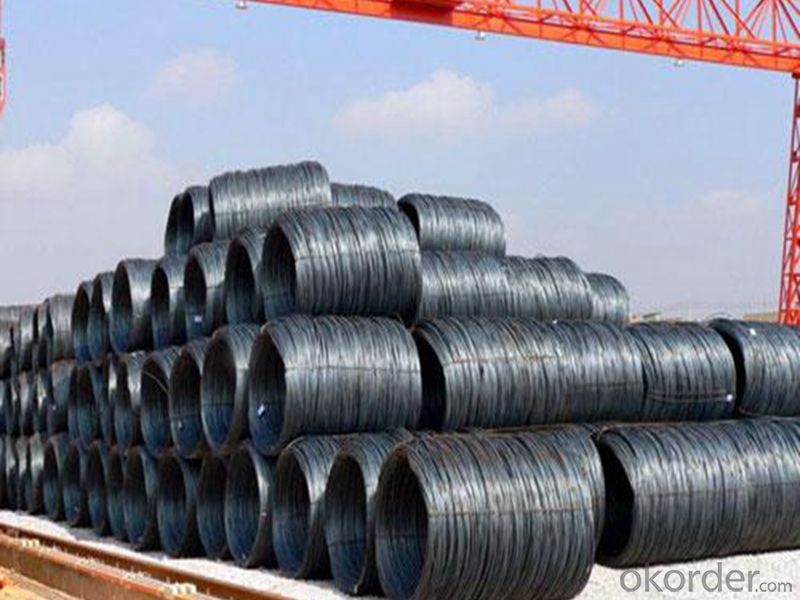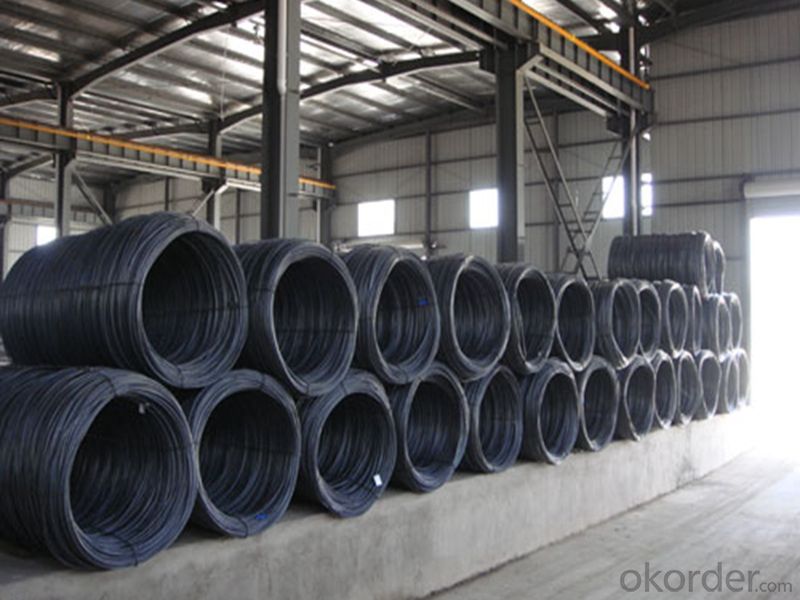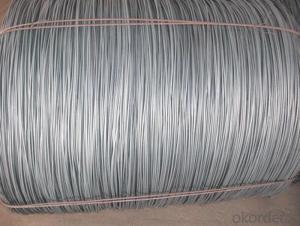6mm hot rolled low carbon 1008B steel wire coil/steel wire rod
- Loading Port:
- Tianjin
- Payment Terms:
- TT OR LC
- Min Order Qty:
- 500 m.t.
- Supply Capability:
- 1000000 m.t./month
OKorder Service Pledge
OKorder Financial Service
You Might Also Like
1. Introduction:
| Standard: | AISI, ASTM, SGS | Grade: | 400 Series | Wire Gauge: | 6mm |
| Length: | M | Application: | construction | Certification: | SGS |
| C Content (%): | 0.03~O.07 | Si Content (%): | ≤0.30 | Place of Origin: | Shandong, China (Mainland) |
| Brand Name: | Xindadi | Model Number: | 6mm | diameter: | 5.5-10mm |
| Steel Grade: | SAE1008B | application: | construction | coil weight: | 1.8-2.1ton |
| Tensile strength: | 350-380 | Elongation: | ≥32 | Yield strength: | 250-280 |
Packaging & Delivery
| Packaging Details: | industrial package or according to customer's requirements |
| Delivery Detail: | valid in 10 days |
2. Specifications:
Name | 6mm hot rolled low carbon 1008B steel wire coil/steel wire rod |
Standard | GB, SAE, SGS, ASTM |
Diameter | 6mm |
Coil weight | 1.8-2.1tons |
MOQ | 40tons |
Deliver Time | 15 days after receipt of L/C or deposit by T/T |
Packing | In coil and load in container, if large quantity, by bulk vessel; can be packed as customers' special requirements |
Payment terms | 1).100% irrevocable L/C at sight.2).30% T/T prepaid and the balance against the copy of B/L.3).30% T/T prepaid and the balance against L/C |
Application | Building material, machinery parts |
3.Application:
Applicationwidely used in machinery parts, manufacturing industry, electronics industry, metal tools and others
4. Pictures


5.FAQ
We have organized several common questions for our clients,may help you sincerely:
①How about your company?
A world class manufacturer & supplier of castings forging in carbon steel and alloy steel,is one of the large-scale professional investment casting production bases in China,consisting of both casting foundry forging and machining factory. Annually more than 8000 tons Precision casting and forging parts are exported to markets in Europe,America and Japan. OEM casting and forging service available according to customer’s requirement.
②How to guarantee the quality of the products?
We have established the international advanced quality management system,every link from raw material to final product we have strict quality test;
- Q:What are the standard dimensional accuracy requirements for steel wire rod?
- The dimensional accuracy requirements for steel wire rod vary depending on its specific application and industry standards. However, there are generally accepted tolerances that are adhered to during the manufacturing and production process. In terms of diameter, the dimensional accuracy requirement typically falls within a certain tolerance limit. For instance, a particular grade of steel wire rod may require the diameter to be within +/- 0.10 mm, allowing for a deviation of up to 0.10 mm from the specified value. This tolerance ensures consistency in size and enables proper fit and function in different applications. Likewise, for the length of the steel wire rod, a dimensional accuracy requirement is set to ensure uniformity and compatibility. The length tolerance may be specified as +/- a certain value, such as +/- 0.5% of the specified length. This tolerance ensures that the wire rod meets the desired length requirements and can be easily incorporated into various manufacturing processes. Furthermore, other dimensional parameters like straightness, surface finish, and ovality may also have specific requirements depending on the intended use of the steel wire rod. These requirements ensure efficient processing, forming, and utilization of the wire rod in different applications, while maintaining the desired quality and performance. It is important to highlight that the precise dimensional accuracy requirements for steel wire rod may vary depending on industry standards, customer specifications, and the intended application. Therefore, it is crucial to consult the relevant standards or communicate with the appropriate stakeholders to determine the exact dimensional accuracy requirements for a specific steel wire rod.
- Q:What are the main factors affecting the market diversification of steel wire rod?
- The main factors affecting the market diversification of steel wire rod are fluctuating demand from various industries, competition from alternative materials, technological advancements in steel production, government policies and regulations, and global economic conditions.
- Q:How is steel wire rod used in the production of wire ropes for ski lifts?
- Steel wire rod plays a crucial role in the production of wire ropes used in ski lifts. This raw material is carefully chosen for its specific properties, including strength, durability, and flexibility, to ensure the wire ropes can handle the heavy loads and constant usage associated with ski lift operations. Once the appropriate steel wire rod is acquired, it goes through a series of processes to transform it into wire ropes. The wire rod is initially cleaned and then heated to a specific temperature to enhance its malleability. It is then passed through various dies to gradually reduce its diameter and shape it into a continuous length of wire. Following this, the individual wires are twisted together to form strands. The configuration of this twisting process, known as stranding, can vary depending on the desired strength and flexibility of the wire rope. The strands are subsequently compacted and laid together around a central core, resulting in the final wire rope structure. The use of steel wire rod in the production of wire ropes for ski lifts offers several advantages. Firstly, steel is renowned for its high tensile strength, enabling the wire ropes to support heavy loads and provide a safe transportation system for skiers. Additionally, the durability of steel ensures that the wire ropes can withstand harsh weather conditions and extreme temperatures on mountain slopes. Furthermore, the flexibility of steel wire rod allows the wire ropes to bend and conform to the pulleys and sheaves used in ski lift systems, ensuring smooth and reliable operation. This flexibility is crucial in preventing sudden failures or damages to the wire ropes during continuous usage. In conclusion, the utilization of steel wire rod in the production of wire ropes for ski lifts is vital for ensuring the safety, reliability, and durability of these transportation systems. The properties of steel, such as its strength and flexibility, make it an ideal material for constructing wire ropes that can withstand the demanding conditions of ski lift operations.
- Q:What are the different types of coatings for steel wire rod?
- Steel wire rods can be enhanced and safeguarded from corrosion through the application of various coatings. Some commonly employed coatings are as follows: 1. Zinc Coating: Galvanization, also known as zinc coating, is a highly favored option for steel wire rods. It ensures exceptional resistance against corrosion and can be applied using hot-dip galvanization or electroplating techniques. 2. Polymer Coating: Polymer coatings are often utilized to provide extra protection against corrosion and abrasion. These coatings can be applied through dip coating, extrusion, or powder coating methods, offering commendable adhesion and flexibility. 3. Phosphate Coating: Phosphate coatings are commonly employed as a pre-treatment for steel wire rods before the application of other coatings. They enhance the adhesion of subsequent coatings and improve corrosion resistance. 4. Epoxy Coating: Epoxy coatings are renowned for their exceptional adhesion and chemical resistance. They find frequent usage in industrial settings where the wire rods are exposed to harsh environments or corrosive substances. 5. Powder Coating: Powder coatings provide a robust and aesthetically pleasing finish to steel wire rods. These coatings are applied as dry powder and then cured under heat to create a smooth and protective layer. 6. Organic Coating: Organic coatings, such as acrylics or polyurethanes, are often employed for aesthetic purposes or to impart a specific color to the wire rods. These coatings also offer a certain degree of corrosion protection. 7. Ceramic Coating: Ceramic coatings find their application in high-temperature scenarios where the wire rods are subjected to extreme heat or thermal cycling. They exhibit excellent heat resistance and can withstand thermal shocks. It is crucial to select the appropriate coating based on the specific requirements and intended use of the steel wire rods. Different coatings provide varying levels of protection, durability, and resistance to specific environmental factors.
- Q:What are the common production processes for molybdenum-coated steel wire rod?
- The common production processes for molybdenum-coated steel wire rod include cleaning and pre-treatment of the steel wire, application of molybdenum coating through methods like electroplating or thermal spraying, and post-treatment processes such as drying and curing to ensure a durable and uniform coating.
- Q:What are the main trends in the steel wire rod industry?
- The steel wire rod industry is experiencing several key trends that are shaping its future. One of the main trends is the increasing demand for steel wire rods in various industries, including construction, automotive, and manufacturing. The construction industry, in particular, is driving the demand for steel wire rods due to the growth in infrastructure projects worldwide. The automotive industry is also a significant consumer of steel wire rods for the production of components such as springs, wires, and cables. As these industries continue to expand, the demand for steel wire rods is expected to increase. Another important trend is the shift towards higher quality and more advanced steel wire rods. With the growing emphasis on sustainability and energy efficiency, manufacturers are seeking steel wire rods that offer superior strength, durability, and corrosion resistance. This has led to the development of innovative steel wire rod grades and processes that deliver enhanced performance characteristics. Additionally, the increasing use of advanced technologies, such as microalloying and controlled cooling, has enabled the production of high-quality steel wire rods with improved mechanical properties. Furthermore, the steel wire rod industry is witnessing a rise in the use of automation and digitization. Manufacturers are adopting advanced manufacturing technologies, such as robotics and artificial intelligence, to improve productivity, reduce costs, and enhance product quality. Automation enables efficient production processes, while digitization facilitates real-time monitoring and control of operations. These technological advancements are driving the transformation of the steel wire rod industry, making it more efficient, flexible, and responsive to market demands. Moreover, sustainability is a critical trend in the steel wire rod industry. Environmental concerns and regulatory requirements have led to increased focus on eco-friendly manufacturing processes and products. Manufacturers are implementing measures to reduce energy consumption, minimize emissions, and optimize resource utilization. This includes the adoption of energy-efficient technologies, recycling initiatives, and the development of eco-friendly steel wire rod grades. Sustainability has become a key driver of innovation and competitiveness in the industry. In summary, the main trends in the steel wire rod industry include increasing demand from various sectors, a shift towards higher quality and advanced products, the adoption of automation and digitization, and a focus on sustainability. These trends are shaping the future of the industry, driving innovation, and creating new opportunities for manufacturers.
- Q:How is the surface finish of steel wire rod evaluated?
- Typically, the evaluation of the surface finish of steel wire rod involves both visual inspection and measurements. Trained personnel use specialized lighting and magnifying tools to visually inspect the wire rod for any imperfections or irregularities, such as scratches, dents, or unevenness. This thorough evaluation ensures the quality of the surface finish. Measurements also play a crucial role in assessing the surface finish of steel wire rod. Different instruments, like profilometers or surface roughness testers, are used to measure the roughness or smoothness of the wire rod's surface. These instruments provide quantitative data, such as Ra (average roughness) or Rz (maximum roughness depth), which can be compared to industry standards or customer specifications to determine if the surface finish is acceptable. Additionally, other quality control techniques, such as dye penetrant testing or magnetic particle inspection, can be used to evaluate the surface finish of steel wire rod. These methods are capable of detecting surface defects, like cracks or fissures, that may not be visible to the naked eye. By applying a penetrant or magnetic particles and examining the wire rod under specific conditions, these tests can identify any hidden imperfections. In summary, the evaluation of the surface finish of steel wire rod involves a combination of visual inspection, measurements, and specialized tests to ensure that it meets the required quality standards and is suitable for its intended application.
- Q:What are the common material specifications for steel wire rod?
- Some common material specifications for steel wire rod include the type of steel used (such as carbon steel or alloy steel), the diameter or gauge of the wire rod, the tensile strength, and the chemical composition of the steel (including elements like carbon, manganese, and silicon). Other specifications may include surface condition, surface quality, and any specific industry standards or certifications required.
- Q:How is steel wire rod used in the production of wire for medical devices?
- Steel wire rod is an essential raw material in the production of wire for medical devices. It serves as the starting point for manufacturing wire that meets the specific requirements of medical applications. The steel wire rod is processed through various stages such as drawing, annealing, and coating to achieve the desired diameter, strength, and surface finish. This wire is then used in the fabrication of medical devices like surgical instruments, catheters, and orthopedic implants, ensuring they possess the necessary strength, flexibility, and biocompatibility required for medical use.
- Q:What are the common raw materials used in steel wire rod production?
- The primary raw materials utilized in the production of steel wire rods are iron ore, coal, and limestone. Steel production heavily relies on iron ore, which is acquired through mining. Coal is utilized as a fuel during the steelmaking process to generate the necessary heat and energy. Limestone is introduced into the steelmaking process as a fluxing agent, aiding in impurity removal and slag formation. Furthermore, different alloying elements like chromium, nickel, and manganese may be incorporated into the steel to attain desired properties. These raw materials play a critical role in manufacturing top-notch steel wire rods that find extensive applications in industries such as construction, automotive, and manufacturing.
1. Manufacturer Overview |
|
|---|---|
| Location | |
| Year Established | |
| Annual Output Value | |
| Main Markets | |
| Company Certifications | |
2. Manufacturer Certificates |
|
|---|---|
| a) Certification Name | |
| Range | |
| Reference | |
| Validity Period | |
3. Manufacturer Capability |
|
|---|---|
| a)Trade Capacity | |
| Nearest Port | |
| Export Percentage | |
| No.of Employees in Trade Department | |
| Language Spoken: | |
| b)Factory Information | |
| Factory Size: | |
| No. of Production Lines | |
| Contract Manufacturing | |
| Product Price Range | |
Send your message to us
6mm hot rolled low carbon 1008B steel wire coil/steel wire rod
- Loading Port:
- Tianjin
- Payment Terms:
- TT OR LC
- Min Order Qty:
- 500 m.t.
- Supply Capability:
- 1000000 m.t./month
OKorder Service Pledge
OKorder Financial Service
Similar products
New products
Hot products
Related keywords




























